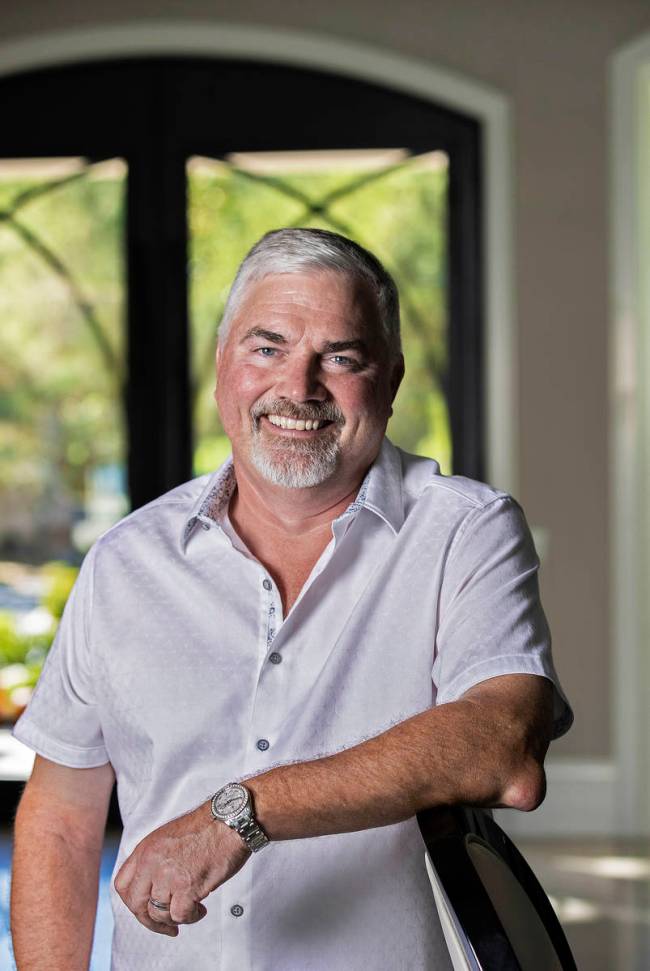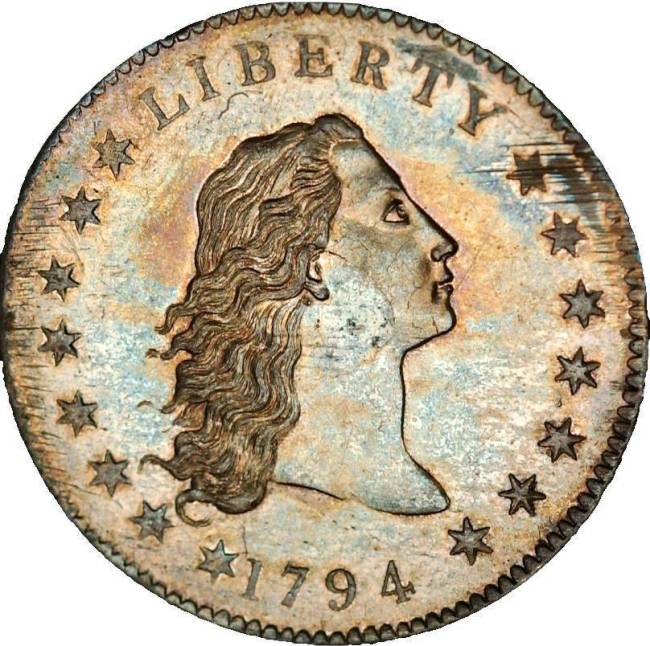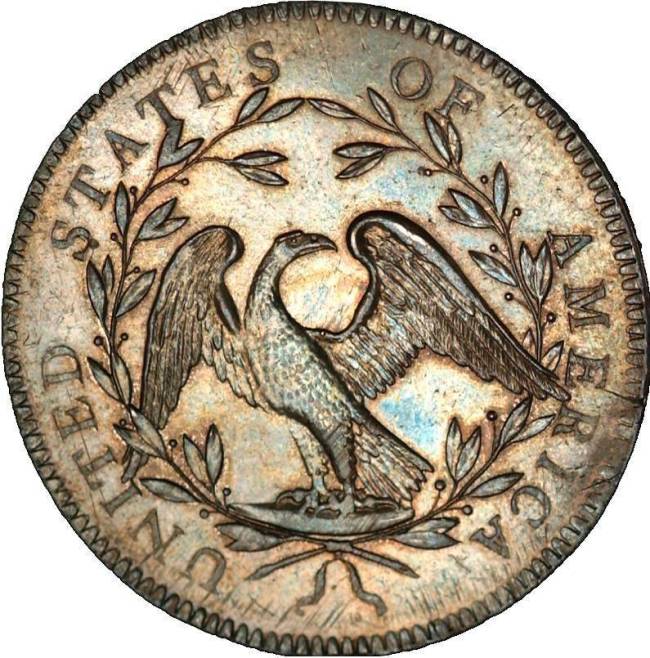World’s most expensive coin a life changer for Las Vegas man
In the rarefied world of exclusive coin buying, there’s a period of high anxiety before any major auction that collectors liken to the fog of war.
That’s where Bruce Morelan and his partner found themselves on Jan. 24, 2013, preparing for an event at a swank New York City hotel.
Anticipating their competitor’s strategies, they’d collected loose talk and reconnaissance, finally ready to make their audacious bid for one of the most-coveted coins in American history.
Their prize — the 1794 Flowing Hair silver dollar — would demand the highest amount paid for any coin ever sold worldwide.

That evening, the 58-year-old Morelan, an entrepreneur who bankrolls his coin-collecting passion through an electrical contracting empire, sat on the living room couch of his home in Southern Highlands, calling the bidding shots by cellphone.
Partner Laura Sperber was inside the exclusive Estrela penthouse suite of Manhattan’s Le Parker Meridien hotel, staring down a phalanx of other suitors seeking the hand of the exotic Lady Liberty posed on the face of the coin.
Experts believe the coin is the first silver dollar ever struck at the nation’s new Philadelphia mint in the fall of 1794, a timeless artifact that provides a unique glimpse into America’s earliest days of independence.
In October, following seven years of coveted ownership, Morelan sought to sell his prized coin at an auction held at the Bellagio in Las Vegas.
Rated at the highest-level “specimen” quality, the 1794 dollar never went into general circulation. U.S. Secretary of State Edmund Jennings Randolph mentioned the minting of the inaugural silver dollars in a letter to President George Washington, who some numismatic scholars believe might even have received one as a historic memento.
Over the next two centuries, the coin up for auction that winter night had changed hands among private collectors. One was so reluctant to part with it, the sale came only after his death. Another wrote a book about the coin’s high quality and cultural relevance.
Back at the 2013 auction, the mood among bidders was tense, even cutthroat.
“We were bogged down in that war fog — you know, figuring that this guy was bidding, that guy was gonna buy it,” recalled Sperber, the founder of Legend Numismatics, a rare-coin firm based in New Jersey. “So we came in there in a real paranoid state. Bruce, being the uber-collector that he is, just had to have this coin.”
When I saw it, my heart dropped to the floor. It had razor-sharp detail. This coin was not like any of the other ones.
Steve Contursi, CEO Rare Coin Wholesalers
In the end, their battle plan was simple: shock and awe.
They would make a blowout bid to scatter the competition like so much coin-collecting collateral damage.
As Morelan recalls, the din inside the auction room forced him to repeat his instructions before Sperber could hear him.
“Do the bid!” he shouted. “Do the bid!”
She raised her card. And then coolly offered $10 million.
With the monster assault made, the room fell silent.
Twice, the auctioneer asked Sperber if she was sure of the bid.
She sure as hell was.
“It worked — it stunned everybody,” Sperber said. “All the faces went straight in disbelief. We knocked ’em all out.”
On that evening, Morelan walked away with what experts consider the ultimate numismatic collectible. He had been prepared to bid up to $13 million.
“To me,” he said, “this coin is absolutely priceless.”
But that was coin collecting then, and this is coin collecting now.
In a move that set the coin-pursuing world abuzz, Morelan announced this summer that he would put his coveted coin up for auction at an October event in Las Vegas.
Like many top-end collectors, he’d found that the pursuit of perfection was more heart-pounding than actually owning it. He had since set his sights on acquiring other pieces and collections. There also were the complexities of possessing an object so valuable it had to be stored in a bank vault and moved about under armed guard when put on display. For fear of causing damage, Morelan has only held his cherished coin through a protective clear plastic sleeve.
Before the auction, he speculated about a would-be buyer. “Anyone interested in early American history should buy this coin,” he said, “maybe add it to a collection that might also include the Betsy Ross flag and the Declaration of Independence.”
Definitely someone with more passion for rare coins than Morelan’s wife.
That January night, three years after relocating to Las Vegas from Washington state, he finally acquired his numismatic Holy Grail, “the coin I’d been wanting to own for more than 20 years.”
He called out to Kelley, his second wife of eight years, “We got it!”
Her reaction was something along the lines of “That’s nice, dear.”
“She was happy for me,” he recalled. “But she’s more into handbags.”
‘The Holy Grail’
The year 1794 highlighted the explosive growth of an emerging new nation.
The U.S. government established a permanent navy and amended the U.S. flag to feature 15 stars and stripes to represent member states.
But establishing a national currency would prove more complicated.
After declaring independence in 1776, the U.S. relied mostly on coins minted by various states and even foreign pieces were accepted as tender.
In 1792, Congress established the U.S. Mint to create a new national coinage. Yet some legislators had argued that the fledgling nation should contract with an experienced foreign minter rather than produce coins that would initially be of lesser quality.
Thomas Jefferson believed that making its own money would help America forge its newfound identity. “Coinage is peculiarly an attribute of sovereignty,” he wrote in a report to Congress. “To transfer its exercise into another country, is to submit it to another sovereign.”
There was also the question of prestige: It was important for the U.S. to produce a coin of size and quality that would impress the Europeans and other trade partners.
On Oct. 15, 1794, the government began striking silver dollars. In those days, minting was a primitive process. Workers used a hand-turned screw press where two dies were brought together against a round planchet that would become the coin.
“Two burly men swung the arms of the press to strike the coin,” said John Dannreuther, co-founder of Professional Coin Grading Service, who has researched the Flowing Hair silver dollar. “The force they mustered determined the striking pressure.”

Because the supply of silver and other metals was limited, only about 2,000 Flowing Hair silver dollar coins were struck. Some were of such inferior quality that only 1,758 were approved for circulation. About 130 of those survive today.
But that first finished coin was as perfect as workers could make it. The face features the iconic Lady Liberty surrounded by 15 stars, the reverse a primitive version of the American bald eagle with open wings, encircled by a wreath.
Experts revel in the coin’s idiosyncrasies. With her flowing tresses trailing behind her, Miss Liberty exudes the carefree demeanor of a young nation, some say. But it is the eagle on the reverse side that many find more endearing.
“It’s scrawny-looking. Some people even call it the skinny chicken,” dealer Steve Contursi said. “It wasn’t a dominant creature. It didn’t scare anybody off. They later changed the design to a more robust, heraldic eagle.”
But all agree on this: Not only was the die pristine, but every detail, from the stars to the strands of Lady Liberty’s hair and the feathers of the eagle, was struck phenomenally.
That day, Secretary Randolph penned a note to Washington: “The silver coin of the U.S. bears upon its face so much neatness and simplicity, that I cannot restrain myself from transmitting a dollar for your inspection.”
Still, no one knows precisely which dollar he sent.
Eventually, the coin Morelan now owns moved between private collections, including that of the son of a Wall Street baroness and newspaper entrepreneur Amon Carter Sr., a co-founder of American Airlines.

As it changed hands, the coin increased in value.
Records show that it sold for $1,250 in 1947 and for $264,000 in 1984. Then it doubled in value, to $506,000 seven years later.
But it wasn’t until Contursi came along in 2002 that the numismatic community began to grasp the coin’s historic significance.
Contursi, the CEO of Rare Coin Wholesalers in Irvine, California, spotted the coin on a kitchen table in Missouri while appraising a group of collectibles known as the Knoxville Collection. “When I saw it, my heart dropped to the floor. It had razor-sharp detail,” he said. “This coin was not like any of the other ones.”
The Flowing Hair dollar was part of a larger set the dealer wanted to sell intact, so Contursi passed. Two weeks later, while coaching a Little League baseball game, he called the dealer back on his flip-top cellphone.
He wanted that coin, he said.
The dealer told him the price had just gone up — by $500,000.
Contursi paid $2 million. Then he hired a team of researchers to determine whether the coin was indeed the first Flowing Hair silver dollar struck in 1794.
Later, the seller’s broker offered to buy the coin back for double the sale price. His response: The coin is not for sale. “It’s a national treasure.”
But is it indeed the first silver dollar ever struck?
“Let me put it this way, we have a horse race with only one horse in the running,” Dannreuther said. “We can’t absolutely prove it, there’s no letter, but like Sherlock Holmes solving a crime, all we can do is evaluate the evidence we have. I’m 99.99 percent certain that this was the first coin struck.”
Not only that, but Morelan believes that George Washington once owned it.
“He was the president, so the logical supposition is that the mint would send him something special, and that would be this coin, the first one.”
After he announced the sale of the silver dollar, Morelan said, a person who identified himself as a distant heir of Washington’s called to say this was indeed the coin the president owned, though a check with Valley Forge produced no records.
Morelan sighed: “All of this really makes me wish I wasn’t selling it.”
Contursi knows the sorrow of disposing of such a precious artifact.
“Like the Declaration of Independence sets out the beliefs of our country, this coin represents a declaration of our economy,” he said. “It was a testimony that we were a real nation, that we could do this, that we would use no country’s coins but our own.”
In his career, Contursi has bought and sold countless coins.
But this one hurt.
“In all my years, I never had any emotional attachment to a coin. This was the only one I ever regretted having to sell,” he said. “I felt like Indiana Jones searching for the Holy Grail. I acquired this silver dollar that many dealers passed over and got the researchers to figure out its real value.”
But in 2010, with the economy reeling and money short, he said, a buyer “made me an offer I couldn’t refuse.”
In a private transaction, he sold the coin to Silicon Valley tax accountant and collector Martin Logies, author of the book “The Flowing Hair Dollars of 1794.”
At the time, the $7.85 million price was a world record.
Three years later, with his blowout bid in New York, Morelan became the latest grail-seeker to take Lady Liberty’s hand.
Risky business
Bruce Morelan seemed destined for a life of wheeling and dealing in rare coins.
As a boy growing up in rural Washington state, he preferred coins to baseball cards, the lingua franca of his peers.
One day, his great-grandmother took down an old teapot where for years she had kept three exotic old coins. She gave Morelan a seated Liberty half dime, 3-cent nickel, and a so-called trade dollar once used to facilitate commerce with China — heady stuff for a coin-collecting kid.
He soon learned that trading in coins was profitable. One day, he bought a rare Morgan silver dollar for $20 and quickly noticed the coin had been minted in Carson City — not New Orleans as the dealer had noted — making it more valuable.
The next day, the 13-year-old went back to the shop and sold it for $55. The dealer laughed as he gave the money to this enterprising kid.
As a high school senior, he took $600 to a coin show, buying and selling among dealers, and left with $1,800. “I told myself, ‘I’ve got a good eye for this,’ ” Morelan recalled. “I wouldn’t mind being a dealer one day.’”
Then life intervened. He joined the Navy, got married, began raising a family and launched his electrical contracting business, Power City Electric.
In 1996, with his career well established, he suddenly had more time for coins.
“As collectors, we often go back to the things that interested us in our youth,” he said. “In our adult years, they bubble up. If you’re interested in rocks or butterflies or coins at age 6, that passion returns in adulthood.”
Flipping through a coin magazine, he saw a picture of the Flowing Hair silver dollar. “I was flabbergasted. How could a coin minted in 1794 have a mint frost that causes it to glow? How could an old coin even look like that? That picture stayed with me.”

Morelan later bought 49 percent of the auction house Legend Numismatics, which has a contract to handle all coin auctions in Las Vegas. Meanwhile, he teamed up with company executive Sperber to build his collection.
In the old days, he took risks that he would never take now.
In 2006, he sold a 1913 Liberty head nickel to a California collector and decided to meet in Las Vegas for the transaction. He took a coach flight from Spokane with the coin, valued at $5 million, in his pocket.
“It seemed smart at the time,” he recalled. “It’s not something I’d ever do again.”
He checked into his hotel and placed the coin in a safe deposit box. The following morning, with two partners in tow, he retrieved the box.
It was empty.
“My heart jumped, my face fell as I showed my partners the empty box,” he said. “I thought ‘How could anyone get inside this thing?’ ”
He consulted the security officer, who admitted he’d handed him the wrong box. Still, he aged 10 years in those 10 seconds.
Morelan is more cautious with his $10 million Flowing Hair silver dollar.
“In the old days, you could keep a coin like this at home,” he said. “But as the value of these coins increases, you’re forced to keep them under lock and key. This dollar has pretty much been in a Spokane bank vault since I bought it.”
In recent years, he considered the once-unthinkable: selling the flowing-haired lady.
“Owning a rare coin is like a marriage, a long-term commitment that takes awhile to get into and get out of,” he said. “It has its ups and downs — the jumping-up-and-down joy of the wedding and those days when you wish you’d never said ‘I do.’ ”
But life goes on for rare-coin collectors like Morelan. In 2010, he moved to Las Vegas from Spokane, largely so he could play golf year-round. With a 9 handicap, he’s serious about the game and recently took a call on his cellphone, saying, “Listen, can I call you back? I just teed off on the back nine at TPC Summerlin.”
When he lived in Washington, Morelan said, he was a so-called “whale,” a big-wager gambler who flew to Las Vegas often. Now that he lives here with wife Kelley and his children — 13-year-old daughter Kiera and twin 6-year-old boys Jasper and Foster — he largely avoids the Strip.
Now coin collecting is his biggest gamble.
Owning a rare coin is like a marriage, a long-term commitment that takes awhile to get into and get out of. It has its ups and downs — the jumping-up-and-down joy of the wedding and those days when you wish you’d never said ‘I do.’
Bruce Morelan
Morelan’s latest coin auction adventure came in October in one of the Bellagio’s convention suites, where a few dozen collectors and auction staff gathered.
Out of 26 coin lots he put up for auction that day, 22 sold.
But not the flowing-haired lady.
The established minimum bid for a sale was $8.2 million, including brokers fees. Nobody offered that much.
Why?
Morelan says at least a half-dozen major buyers were not at the convention, because of death or personal circumstances. And then there was the challenge of holding a coin auction in the middle of a pandemic.
For Morelan, the no-sale brought mixed emotions. His greatest fear was that someone would make off with his prized coin for the minimum required bid. He wanted to recoup his investment or not sell at all.
When the day was done, Morelan lost more than $1 million on the coins he did sell.
The good news was that he still had his 1794 Lady Liberty.
“I personally feel this coin is priceless,” he said. “But there was a (tinge) of bewilderment that (potential buyers) didn’t share the same belief I did.”
Regardless, his prized $10 million silver dollar always has been more than just an investment.
Five years ago, Morelan and his then-14-year-old son from his first marriage displayed the coin on a 12-city tour across Europe. He remembers one day in London, beaming with pride, being interviewed by the BBC — with son Christopher by his side.
“Unfortunately, we haven’t spent as much time together as we should have,” Morelan said. “We bonded on that trip. And that coin was the reason why.”
Lady Liberty must have smiled that day.












